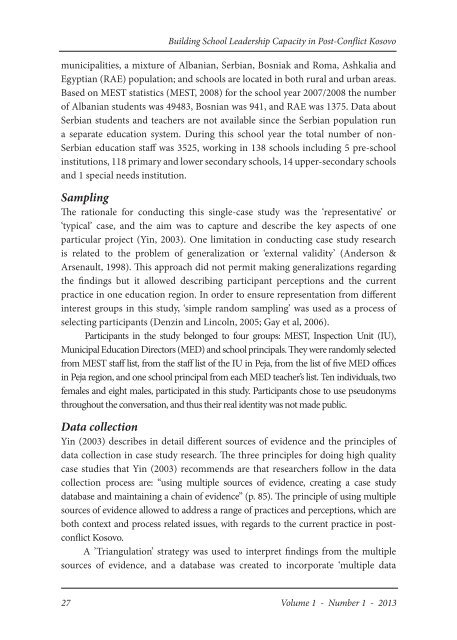Download - qendra per arsim demokratik
Download - qendra per arsim demokratik
Download - qendra per arsim demokratik
You also want an ePaper? Increase the reach of your titles
YUMPU automatically turns print PDFs into web optimized ePapers that Google loves.
Building School Leadership Capacity in Post-Conflict Kosovomunicipalities, a mixture of Albanian, Serbian, Bosniak and Roma, Ashkalia andEgyptian (RAE) population; and schools are located in both rural and urban areas.Based on MEST statistics (MEST, 2008) for the school year 2007/2008 the numberof Albanian students was 49483, Bosnian was 941, and RAE was 1375. Data aboutSerbian students and teachers are not available since the Serbian population runa separate education system. During this school year the total number of non-Serbian education staff was 3525, working in 138 schools including 5 pre-schoolinstitutions, 118 primary and lower secondary schools, 14 up<strong>per</strong>-secondary schoolsand 1 special needs institution.SamplingThe rationale for conducting this single-case study was the ‘representative’ or‘typical’ case, and the aim was to capture and describe the key aspects of oneparticular project (Yin, 2003). One limitation in conducting case study researchis related to the problem of generalization or ‘external validity’ (Anderson &Arsenault, 1998). This approach did not <strong>per</strong>mit making generalizations regardingthe findings but it allowed describing participant <strong>per</strong>ceptions and the currentpractice in one education region. In order to ensure representation from differentinterest groups in this study, ‘simple random sampling’ was used as a process ofselecting participants (Denzin and Lincoln, 2005; Gay et al, 2006).Participants in the study belonged to four groups: MEST, Inspection Unit (IU),Municipal Education Directors (MED) and school principals. They were randomly selectedfrom MEST staff list, from the staff list of the IU in Peja, from the list of five MED officesin Peja region, and one school principal from each MED teacher’s list. Ten individuals, twofemales and eight males, participated in this study. Participants chose to use pseudonymsthroughout the conversation, and thus their real identity was not made public.Data collectionYin (2003) describes in detail different sources of evidence and the principles ofdata collection in case study research. The three principles for doing high qualitycase studies that Yin (2003) recommends are that researchers follow in the datacollection process are: “using multiple sources of evidence, creating a case studydatabase and maintaining a chain of evidence” (p. 85). The principle of using multiplesources of evidence allowed to address a range of practices and <strong>per</strong>ceptions, which areboth context and process related issues, with regards to the current practice in postconflictKosovo.A ’Triangulation’ strategy was used to interpret findings from the multiplesources of evidence, and a database was created to incorporate ‘multiple data27Volume 1 - Number 1 - 2013


